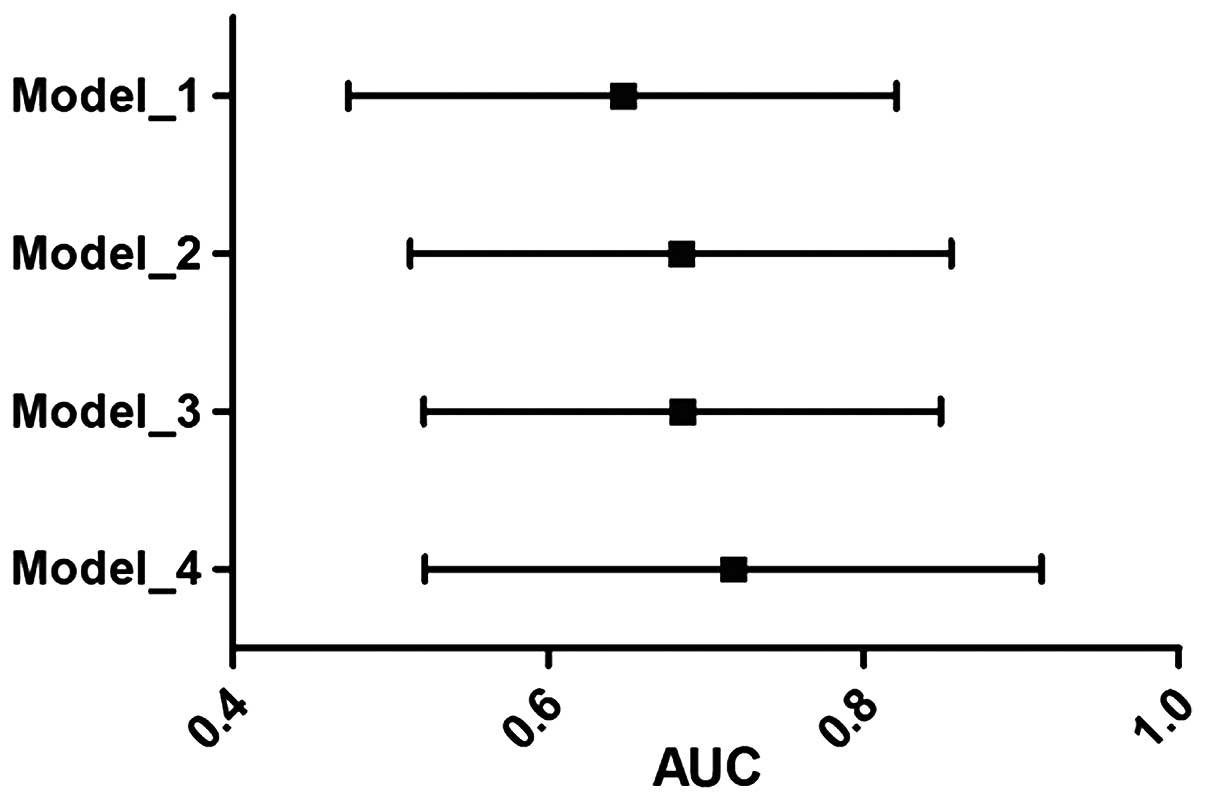|
1
|
Kanjilal S, Rao VS, Mukherjee M, Natesha
BK, Renuka KS, Sibi K, Iyengar SS and Kakkar VV: Application of
cardiovascular disease risk prediction models and the relevance of
novel biomarkers to risk stratification in Asian Indians. Vasc
Health Risk Manag. 4:199–211. 2008. View Article : Google Scholar : PubMed/NCBI
|
|
2
|
Mathers CD and Loncar D: Projections of
global mortality and burden of disease from 2002 to 2030. PLoS Med.
3:e4422006. View Article : Google Scholar : PubMed/NCBI
|
|
3
|
Greenland P, Knoll MD, Stamler J, Neaton
JD, Dyer AR, Garside DB and Wilson PW: Major risk factors as
antecedents of fatal and nonfatal coronary heart disease events.
JAMA. 290:891–897. 2003. View Article : Google Scholar : PubMed/NCBI
|
|
4
|
Khot UN, Khot MB, Bajzer CT, Sapp SK,
Ohman EM, Brener SJ, Ellis SG, Lincoff AM and Topol EJ: Prevalence
of conventional risk factors in patients with coronary heart
disease. JAMA. 290:898–904. 2003. View Article : Google Scholar : PubMed/NCBI
|
|
5
|
Goyal A and Yusuf S: The burden of
cardiovascular disease in the Indian subcontinent. Indian J Med
Res. 124:235–244. 2006.PubMed/NCBI
|
|
6
|
Sharma M and Ganguly NK: Premature
coronary artery disease in Indians and its associated risk factors.
Vasc Health Risk Manag. 1:217–225. 2005.PubMed/NCBI
|
|
7
|
Atar AI, Yilmaz OC, Akin K, Selcoki Y, Er
O and Eryonucu B: Association between gamma-glutamyltransferase and
coronary artery calcification. Int J Cardiol. 167:1264–1267. 2013.
View Article : Google Scholar : PubMed/NCBI
|
|
8
|
Poelzl G, Eberl C, Achrainer H, Doerler J,
Pachinger O, Frick M and Ulmer H: Prevalence and prognostic
significance of elevated gamma-glutamyltransferase in chronic heart
failure. Circ Heart Fail. 2:294–302. 2009. View Article : Google Scholar : PubMed/NCBI
|
|
9
|
Paolicchi A, Emdin M, Ghliozeni E, Ciancia
E, Passino C, Popoff G and Pompella A: Images in cardiovascular
medicine. Human atherosclerotic plaques contain gamma-glutamyl
transpeptidase enzyme activity. Circulation. 109:14402004.
View Article : Google Scholar : PubMed/NCBI
|
|
10
|
Shanker J, Maitra A, Rao VS, Mundkur L,
Dhanalakshmi B, Hebbagodi S and Kakkar VV: Rationale, design &
preliminary findings of the Indian atherosclerosis research study.
Indian Heart J. 62:286–295. 2010.PubMed/NCBI
|
|
11
|
Dhingra R, Gona P, Wang TJ, Fox CS,
D'Agostino RB Sr and Vasan RS: Serum gamma-glutamyl transferase and
risk of heart failure in the community. Arterioscler Thromb Vasc
Biol. 30:1855–1860. 2010. View Article : Google Scholar : PubMed/NCBI
|
|
12
|
Emdin M, Passino C, Michelassi C, Donato
L, Pompella A and Paolicchi A: Additive prognostic value of
gamma-glutamyltransferase in coronary artery disease. Int J
Cardiol. 136:80–85. 2009. View Article : Google Scholar : PubMed/NCBI
|
|
13
|
Ruttmann E, Brant LJ, Concin H, Diem G,
Rapp K and Ulmer H: Vorarlberg Health Monitoring and Promotion
Program Study Group: Gamma-glutamyltransferase as a risk factor for
cardiovascular disease mortality: An epidemiological investigation
in a cohort of 163,944 Austrian adults. Circulation. 112:2130–2137.
2005. View Article : Google Scholar : PubMed/NCBI
|
|
14
|
Wannamethee G, Ebrahim S and Shaper AG:
Gamma-glutamyltransferase: Determinants and association with
mortality from ischemic heart disease and all causes. Am J
Epidemiol. 142:699–708. 1995.PubMed/NCBI
|
|
15
|
Karp DR, Shimooku K and Lipsky PE:
Expression of gamma-glutamyl transpeptidase protects ramos B cells
from oxidation-induced cell death. J Biol Chem. 276:3798–3804.
2001. View Article : Google Scholar : PubMed/NCBI
|
|
16
|
Takahashi Y, Oakes SM, Williams MC,
Takahashi S, Miura T and Joyce-Brady M: Nitrogen dioxide exposure
activates gamma-glutamyl transferase gene expression in rat lung.
Toxicol Appl Pharmacol. 143:388–396. 1997. View Article : Google Scholar : PubMed/NCBI
|
|
17
|
Paolicchi A, Tongiani R, Tonarelli P,
Comporti M and Pompella A: gamma-Glutamyl transpeptidase-dependent
lipid peroxidation in isolated hepatocytes and HepG2 hepatoma
cells. Free Radic Biol Med. 22:853–860. 1997. View Article : Google Scholar : PubMed/NCBI
|
|
18
|
Stark AA: Oxidative metabolism of
glutathione by gamma-glutamyl transpeptidase and peroxisome
proliferation: The relevance to hepatocarcinogenesis. A hypothesis.
Mutagenesis. 6:241–245. 1991. View Article : Google Scholar : PubMed/NCBI
|
|
19
|
Stark AA, Russell JJ, Langenbach R, Pagano
DA, Zeiger E and Huberman E: Localization of oxidative damage by a
glutathione-gamma-glutamyl transpeptidase system in preneoplastic
lesions in sections of livers from carcinogen-treated rats.
Carcinogenesis. 15:343–348. 1994. View Article : Google Scholar : PubMed/NCBI
|
|
20
|
Fukami K, Yamagishi S, Iida S, Matsuoka H
and Okuda S: Involvement of iron-evoked oxidative stress in
smoking-related endothelial dysfunction in healthy young men. PLoS
One. 9:e894332014. View Article : Google Scholar : PubMed/NCBI
|
|
21
|
Shanker J, Rao VS, Ravindran V,
Dhanalakshmi B, Hebbagodi S and Kakkar VV: Relationship of
adiponectin and leptin to coronary artery disease, classical
cardiovascular risk factors and atherothrombotic biomarkers in the
IARS cohort. Thromb Haemost. 108:769–780. 2012. View Article : Google Scholar : PubMed/NCBI
|
|
22
|
Kozakova M, Palombo C, Eng MP, Dekker J,
Flyvbjerg A, Mitrakou A, Gastaldelli A and Ferrannini E: RISC
Investigators: Fatty liver index, gamma-glutamyltransferase and
early carotid plaques. Hepatology. 55:1406–1415. 2012. View Article : Google Scholar : PubMed/NCBI
|










